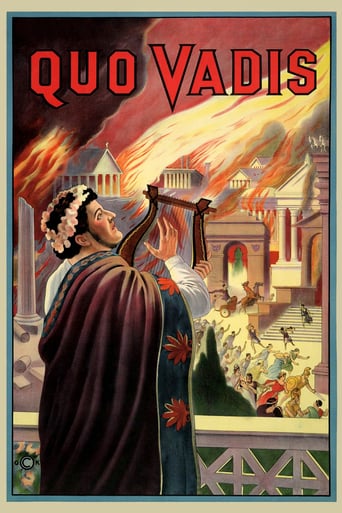

Good start, but then it gets ruined
... View MoreThis is one of the few movies I've ever seen where the whole audience broke into spontaneous, loud applause a third of the way in.
... View MoreThere are moments that feel comical, some horrific, and some downright inspiring but the tonal shifts hardly matter as the end results come to a film that's perfect for this time.
... View MoreThis movie feels like it was made purely to piss off people who want good shows
... View More"Quo Vadis?" (1913) was a landmark in early Italian historical epic films and certainly Herr Enrico Guazzoni's grand scale masterpiece laid the foundations for what genuine kolossal Italian spectacles should be. It had a great deal of influence on Herr Giovanni Pastrone's "Cabiria" 1914) and D.W. Griffith's "Intolerance" (1916).It is easy to see why "Quo Vadis?" shocked early silent audiences because even today to watch this astonishing oeuvre is like visiting an archaeological delicatessen and is a pleasure for silent fans. The film is a larger-than-life picture that was based on a Polish historical novel written by Henryk Sienkiewicz. The book was adapted for the silent and talkie screen many times but the story is so complex that it is hard to summarize in film form. There are a lot of Romans, an incendiary Caesar, many Christians and a horde of extras. Sometimes this Herr Graf got a little confused trying to remember who loves who and who is conspiring against whom."Quo Vadis?" is typical of Herr Guazzoni with his eye for details and his skill in using his big budget to maximum effect. The film is well paced and of course there are many great set pieces: Rome in flames, a chariot race and a coliseum full of gladiators, helpless Christians and very hungry lions. Besides the grand spectacle, the film includes also more prosaic subjects like morality and faith in reference to the early Christians and the struggle of this new religion and its human values in the face of Roman decadence and barbarism.In technical aspects, "Quo Vadis?" is a surprising oeuvre for its detailed framing wherein the depth of field works very effectively in focusing the viewer' s attention right where it needs to be when some much is happening on screen.Unfortunately "Quo Vadis?" hasn't had the well-earned praise of other similar Italian historical epic films; that's what usually happens with the pioneers. These early and innovative masters have their work copied by advanced pupils who end up with the fame and glory. As the German saying goes: "raise crows, and they'll gouge out your eyes" And now, if you'll allow me, I must temporarily take my leave because this German Count must throw some servants into the Schloss' Coliseum arena.Herr Graf Ferdinand Von Galitzien http://ferdinandvongalitzien.blogspot.com
... View MorePerhaps the best film made to its date, 'Quo Vadis?' is an astonishing masterpiece. At a time in which most movies comprised 2 reels (running for about 20-24 minutes) this early feature was certainly the best epic film till 'Cabiria' (1914) was released. Based on the memorable novel written by Henryk Sienwiewicz, this adaptation is more faithful to the book than the 1951 MGM version (this version was called 'Quo Vadis' without the final ?, for it was thought to be bad luck an interrogation mark at the end of a title). I haven't seen the 2001 polish version yet, which was submitted to the Academy Awards (but not nominated) as Best Foreing Language Film but, since it didn't get very positive reviews, I'd dare say this 'Quo Vadis?' is the very best of them all.First of all 'Quo Vadis'? was originally released in 1912 not in 1913, it premiered all over the world in 1913: USA, Spain, Poland, France... But the original Italian release was in 1912. Now, over a year ago the existence of this film was unknown by many people who were asking over and over whether or not this one was available. There was only one review on the film here and the IMDb claimed it was a lost film so there was a lot of talk about it! Nothing further from the truth, ever since I uploaded it on youtube, doubts have been vanished.'Quo Vadis?' is a maserpiece for its date. The portrayal of Nero and all the characters is very accurate, the epic scenes with Rome in the background or the circus, extras, dialogs... Everything is awesome! The dialogs especially are very accurate too, saying as much as needed to make the complex story understandable, not saying too much but not too little either, just the right words. If you're into early film history this is certainly a must-see!! If you like epic movies, roman atmosphere, this kind of literature or whatever topic related to this particular movie this is a must-see. And if you aren't into silent films but you'd ever consider watching one, this is a good choice. Though not as good as Caligari, Potemkin or Nosferatu (after all film techniques would evolve a lot within the next few years), very worth watching either way.
... View MoreStunning, for its day.I saw this many years ago at the National Film Theatre in London. The acting is stagey, and nineteenth century in style, so it's more excessive than anything that you see in the later Hollywood silent films. But they use real locations, and they tell a real plot - although they are still trying to work out how to do this. Birth of a Nation is a sophisticated modern film in comparison. Things moved very far in a few short years.Oh yes, the lions. Well NFT had got that story in the notes somewhere (that they ate an extra on film), so I kept an eye open. But you couldn't possibly tell one way or another. The scene is a bit shambolic - just as if you'd put a camera in the midst of lions in a circus, and didn't know which the interesting bits were going to be. So, no real closeups. The camera just wanders around, making it distanced, banal, and yet utterly real.If you are interested in film history and get a chance to see this, *do*.
... View MoreProbably the first feature film (over 60 min.) ever, this movie has gigantic sets that rival those of movies made years later. All camera shots are stationary, but this doesn't seem to take away from the story much. The story is fairly close to the book with a few liberties--definitely closer than the 1951 version. Obviously the idea of writing a full-length feature film still needed some work. Characters are simply introduced doing things as though the viewer already knows them. St. Peter steals the show in the last half. He's got some great scenes. An important film to watch for anyone who wants to see early breakthroughs in cinema. It's also a good study of early Christianity in cinema.
... View More